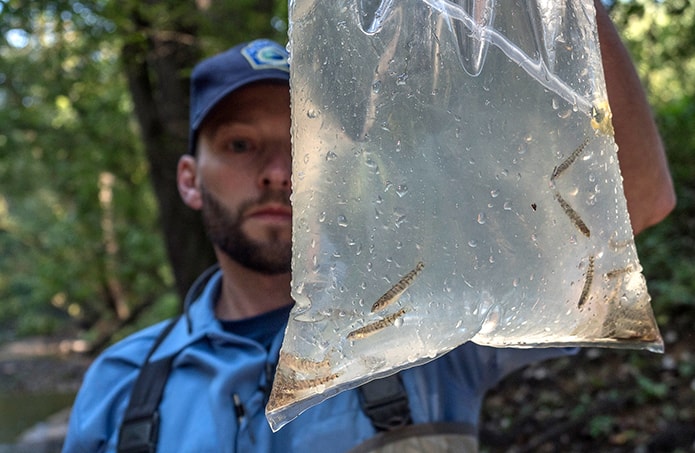By Ad Crable, Bay Journal News Service
Just a few miles from where they were first discovered in 1842, about 100 globally rare Chesapeake logperch, raised in captivity, were released with great fanfare Sept. 27 into a tributary of the Susquehanna River in Lancaster County, PA.
A phalanx of government officials and members of conservation groups, all holding cameras, stood by in waders and rolled-up pants as the 1.5-inch fingerlings were eased into the sun-dappled riffles from oxygenated plastic bags and sent on their way.
The day before, biologists had taken steps to give the fish their best chance of survival: They gently electro-shocked the water to raise other fish to the surface and captured 15 species that might compete with — or eat — the new releases. The species of concern were relocated to the mainstem of the river, said Doug Fischer, a biologist with the Pennsylvania Fish and Boat Commission.
It was a milestone just one year into a four-year project to reintroduce the tiny member of the perch family to a handful of Susquehanna tributaries in southern Pennsylvania. The hope is to keep the fish off the federal endangered species list.

So far, the project is going swimmingly. From 28 fish captured in March from three Pennsylvania streams just north of the Maryland line, about 1,500 fingerlings were raised in propagation tanks in Tennessee and at Penn State University, along with sand and pebbles from their home streams.
About 800 of them were stocked last week over two days into Chiques Creek, just a few miles from where botanist Samuel S. Haldeman discovered the logperch species in 1842. The fish disappeared from the creek long ago, probably the result of a combination of dams, which block their spawning runs, and pollution.
Haldeman reported his findings and described the fish’s zebralike dark bars to the nation’s nascent scientific community. But the fish were mistakenly lumped in with other logperch darters. Then, in 2008, DNA testing proved that Haldeman’s fish was a separate species that only lived in the mainstem of the lower Susquehanna in Maryland and Pennsylvania and its tributaries, as well as the lower Potomac River drainage in Virginia. As such, it earned a new name: the Chesapeake logperch.
None have been found in the Potomac Basin since 1938. But they were found in recent years in a handful of Susquehanna tributaries in Pennsylvania and Maryland.

The discovery set off a save-the-Chesapeake logperch effort with partners that include the state fishery agencies in Pennsylvania and Maryland, U.S. Fish and Wildlife Service, Pennsylvania Biological Survey, Pennsylvania Wild Resource Conservation Fund, Susquehanna River Basin Commission and others.
Adult logperch captured from three Lancaster County streams were sent to a rearing facility in Knoxville, TN, run by Conservation Fisheries, Inc., a nonprofit dedicated to propagating nongame fish, many of them imperiled species. The fish reproduced better than anyone had hoped. Later, the young were transported to Penn State to fatten up and be close to stocking sites.
This fall, project managers have begun returning Chesapeake logperch to native streams from which they had long vanished. The fish were tested to make sure they were not carrying any diseases or parasites.
Releases will be into tributaries instead of the river because scientists said they believed the fish could find each other more easily.
Also, by releasing the young logperch in Chiques Creek, scientists hope that the fish will imprint on the creek and return in another two years or so when they are ready to spawn. To find out, the little logperch are fitted with color-coded tags so they can be identified later as part of the group released into Chiques Creek.

“I’m very excited about it,” said Jay Stauffer, a professor of ichthyology at Penn State University. “We have every reason to believe they will reproduce and this project will be a success.” Stauffer first caught Chesapeake logperch as a teen doing volunteer work in 1969. At the time, he had no idea he was handling a rare fish and would later be involved in the effort to bring them back.
The team will be working for another three years to propagate logperch and reintroduce them into perhaps three more home waters devoid of the species. To begin a new round of propagation, they have already captured about 50 adult logperch in a different in Lancaster County stream and in another stream across the Susquehanna in York County.
They’ll also be monitoring the activities of released fish.
One sign of success will be finding the released, tagged fish later swimming as adults in the Susquehanna. That will be an elusive search, but scientists will use scuba divers, underwater drones and low dosage electric nets to aid their quest.



